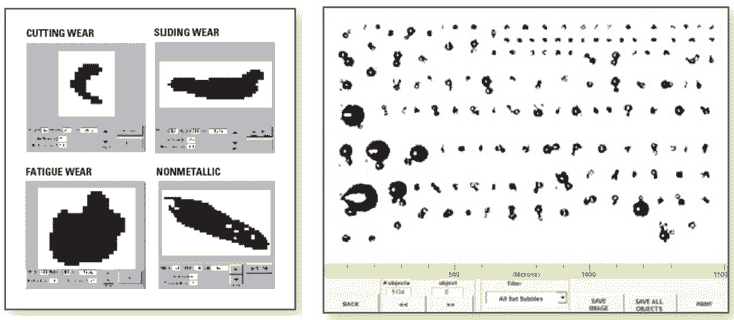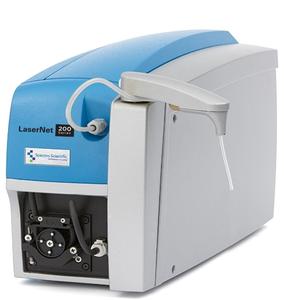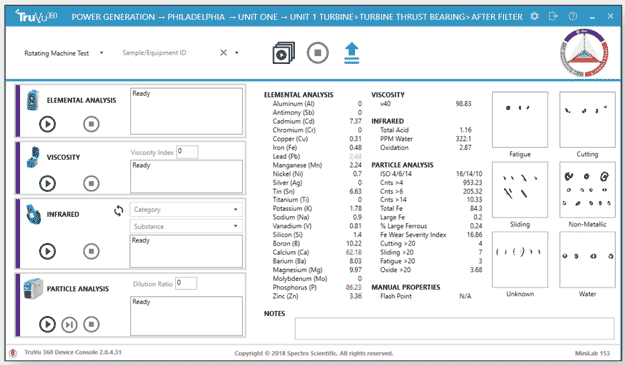Highlights
The LaserNet 200 Series allows reliability professionals to quickly and easily assess machinery health on site in just minutes. With a simple push of a button, a comprehensive picture of machine wear is generated with only a few parameters:
- Particle cleanliness codes, such as ISO 4406 and ASTM D6786, indicate the overall cleanliness of the oil
- Ferrous Wear Severity Index (FWSI) indicates overall severity of the machine wear condition
- Count of large cutting, sliding and fatigue wear, along with non-metallic particles, indicates the source of the particles
Having this information allows reliability professionals to make informed decisions on the maintenance of their critical assets.

Operating principles

LaserNet Fines® was developed by Lockheed Martin and the Naval Research Laboratory to identify the type, rate of production and severity of mechanical faults by measuring the size distribution, rate of progression and shape of wear debris in lubricating oil. It has been successfully deployed aboard naval vessels in an oil analysis-based predictive maintenance program, and used by oil analysis labs worldwide as the best oil particle analyzer on the market.
The center piece of LaserNet Fines® technology is the combination of flow cell (100 micron path length), a high power infrared laser source and a high speed (100 frames per second) CCD camera (640X480 resolution). Oil, along with particles, flows through the flow cell, which is illuminated by the laser and the shadows of the particles are captured by the high speed camera. Image analysis produces particle size and distribution according to various standard formats.
Particle shapes are analyzed by the software with artificial intelligence (Neural Network). The Neural Network was trained by tribology experts using Ferrographic analysis of data from real life in-service oil samples. Particles larger than 20 micron maximum diameter are automatically classified into cutting wear (or abrasive wear), sliding wear (or adhesive wear), fatigue wear, fibers, or non-metallic particles (sand and dirt). Water droplets and air bubbles can be classified as well. The bubble counts are removed from final particle count and distribution. The laser is powerful enough to see through dark engine oil samples with up to 2% soot, making it the only particle analyzer on the market that can test engine oil without dilution.
Two pairs of precision balanced coils (large and small) are included in the LaserNet 230 model. The small coils count ferrous particles larger than 25 micron as they flow through the coil, producing a size distribution. The large coils measure the total ferrous content in part per million (by weight).
Key Features
ASTM D7596 – Standard Test Method for Automatic Particle Counting and Particle Shape Classification of Oils Using a Direct Imaging Integrated Tester
Particle count features
- Particle Count for all particles from 4 μm to 100 μm
- Highest saturation limit, up to 10,000,000 particles/ml with a coincidence error <2%
- Viscosity range ISO15 to ISO320, undiluted
- Images through dark fluids containing up to 2% soot with automatic laser gain control
- Error corrections for water and air bubbles
- Particle counts and codes per ISO 4406, NAS 1638, NAVAIR 01-1A-17, SAE AS 4059, GOST, ASTM D6786, HAL, and User defined bins.
- Export data into LIMS software
Automatic shape classification features
- Automatically classify particles larger than 20 micron (maximum diameter)
- 7 classes – cutting wear, sliding wear, fatigue wear, non-metallic, water droplets, air bubbles, fiber. User can reclassify particles manually
- Numerical count of each classes can be used for trending analysis
Ferrous particle analysis features
- < 10 ppm for total ferrous concentration
- Detects ferrous particles over 25 microns, equivalent circular diameter
- 20 second additional test time for Ferrous measurement
- Reports large Ferrous concentration (PPM), percentage of large Ferrous particles (PLFP), Ferrous Wear Severity Index (FWSI)
Auto-Sampling Process for high throughput sample processing
LaserNet 200 series is equipped with an optional auto-sampling processer (ASP). It holds 24 samples in a carousel sample tray and automatically stirs sample bottles to homogenize particle distribution before each measurement. It automatically cleans and rinses the stir paddle and all the tubing after each measurement. It typically takes 2 to 3 hours to complete 24 samples. Actual run time varies by oil viscosity and cleanliness.

Analytical Tests and Features by model:
There are four models in the LaserNet 200 series. Below table details the difference among the three models.
| LaserNet 200 SERIES COMPARISON | 210 | 215 | 220 | 230 |
| Total particle count & codes | v | v | v | v |
| Non-metallic particles (sand/dirt) | v | v | v | v |
| Free water measurement | v | v | v | v |
| Air bubble/water droplet correction | v | v | v | v |
| Wear particle classification | v | v | ||
| Total Ferrous concentration | v | v | ||
| Ferrous particle count & size distribution | v | v | ||
| Large ferrous concentration | v | v | ||
| Autosampler option | v | v | v | v |
The LaserNet 200 Series system employs an innovative, patented approach to testing the fluid directly from the sample bottle. The core of the device combines a direct imaging particle analyzer with a sensitive magnetometer together to generate both particle counts, images and ferrous concentration in ppm. Oil and fluid samples are passed through a flow cell, illuminated by a laser, and a CCD video camera counts and classifies the particles from the image data. This technique provides the user with a very reliable and accurate particle counter that can tolerate a wide range of dirty and clean samples, with varying viscosities.
The capability of the LaserNet Fines to capture the actual wear particle silhouette allows for an ‘Automated Ferrography’ capability for wear particle classification. All particles larger than 20 μ are classified by a neural network in categories such as cutting, fatigue, severe sliding, non-metallic, free water and fibers.

Data Management
The LaserNet 200 Series has a data export capability to laboratory LIMS systems as well as comma or tab delimited text file formats. The wear images can be exported as .jpeg or .bmp files.
Spectro Scientific’s TruVu 360 Device Console (TDC) fully integrates the LaserNet 200 with the TruVu 360 Enterprise Fluid Intelligence platform.TruVu 360 Enterprise Fluid Intelligence Platform
The LaserNet Series system fulfills the wear and contamination measurement of the MiniLab system, and it is designed to communicate seamlessly with the TruVu360 fluid intelligence platform.

